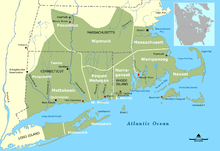| Total population | |
|---|---|
| unknown but estimates in the hundreds (2023)[1][2] | |
| Regions with significant populations | |
| United States (Connecticut)[3] | |
| Languages | |
| Quiripi language | |
| Religion | |
| Indigenous religion | |
| Related ethnic groups | |
| Other Algonquian peoples[4] |

The Wangunk or Wongunk are an Indigenous people from central Connecticut.[5][3] They had three major settlements in the areas of the present-day towns of Portland, Middletown, and Wethersfield. They also used lands in other parts of what were later organized by English settlers as Middlesex and Hartford counties.[6] Some sources call the Wangunk the Mattabessett, or Mattabesch, but Wangunk is the name used by scholars and by contemporary Wangunk descendants.[6][7][1][2][5]
Prior to European contact, the Wangunk spoke Quiripi, which is part of the large Algonquian language family and had strong connections with other of the many Algonquian nations, whose territory was along the Atlantic coast and rivers leading to the sea.[4] Currently, no Wangunk political organization is a state-recognized tribe by Connecticut[8] or federally recognized as a Native American tribe;[9] however there are contemporary Wangunk descendants living in Middletown who maintain kinship connections and cultural traditions. According to 2023 statements from Wangunk Elder Red Oak (Gary O'Neil), "hundreds of Wangunks" are living today, including in Connecticut, Massachusetts, and Rhode Island.[1][2]
In October 2023, City of Middletown Mayor Benjamin Florsheim presented a proclamation in recognition of Indigenous Peoples' Day to Wangunk Elder Red Oak (Gary O'Neil).[5] A press release from the Mayor's office read, "The Wangunk people are the native inhabitants and caretakers of the land in and around Middletown, and have lived in this area for thousands of years. The Wangunk people have persisted to this day through their resiliency and spirit.”[5]
A November 2023 press release from the Mayor's office added that "all of the Middletown area" "is Wangunk land," and highlighted the importance of "bring[ing] awareness and recognition to the Wangunk people, who are sometimes referred to as a “lost tribe.'”[10]
These statements from local government mark important steps in combating the popular erasure and extinction narrative of the Wangunk as a continued people.[2]
- ^ a b c "Middletown honors Wangunk Elder Gay O'Neil, marks Indigenous Peoples Day". The Middletown Press. Retrieved 17 March 2024.
- ^ a b c d "Letter from Connecticut: The extinction of the Wangunks has been greatly exaggerated". Daily Maverick. Retrieved 17 March 2024.
- ^ a b De Forest, John William (1853). History of the Indians of Connecticut from the Earliest Known Period to 1850. Hartford, CT: W. J. Hammersley. p. 368.
- ^ a b Bacon, R. W. (2010). "Native Americans in Middletown: Who called it 'home' before our 'First Settlers'?". The Middler. 10 (1–2).
- ^ a b c d "Mayor Ben Florsheim will present proclamation to Wangunk Elder Red Oak (Gary O'Neil) in Recognition of Indigenous Peoples' Day". City of Middletown Office of the Mayor. Retrieved 17 March 2024.
- ^ a b Grant-Costa, Paul. "Wangunk". Yale Indian Papers Project. Yale University. Retrieved Dec 15, 2015.
- ^ Ives, Timothy (2011). "Reconstructing the Wangunk Reservation Land System: A Case Study of Native and Colonial Likeness in Central Connecticut". Ethnohistory. 58: 65–89. doi:10.1215/00141801-2010-064.
- ^ "State Recognized Tribes". National Conference of State Legislatures. Retrieved 11 April 2022.
- ^ "Indian Entities Recognized by and Eligible To Receive Services From the United States Bureau of Indian Affairs". Indian Affairs Bureau. Federal Register. 11 April 2022. pp. 7554–58. Retrieved 21 January 2022.
- ^ "Local Wangunk Art Show to Open at Russell Library". City of Middletown Office of the Mayor. Retrieved 17 March 2024.